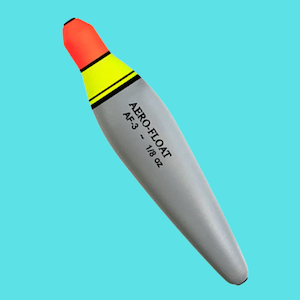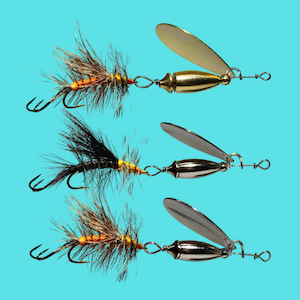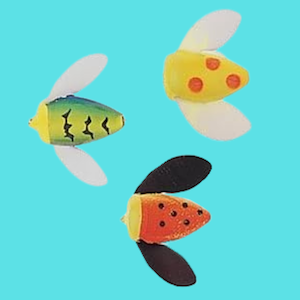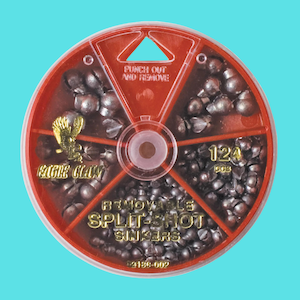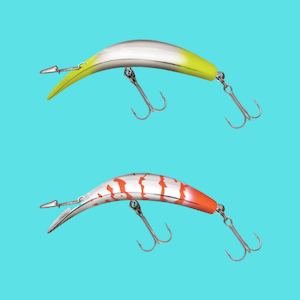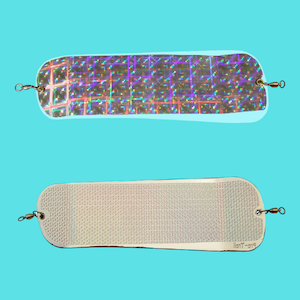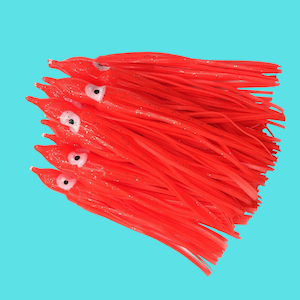Rigging For Salmon (9 Rigs You Need To Know)
UPDATED 03 NOVEMBER 2023
by Robert Ceran
Salmon are one of the most sought after game fish in the world.
But if you want to catch salmon successfully and avoid getting skunked, it’s essential to use the right rigs for the job.
For example, when targeting coho salmon in a river, you’ll need to use a completely different salmon fishing rig than when trolling for big king salmon deep in the ocean.
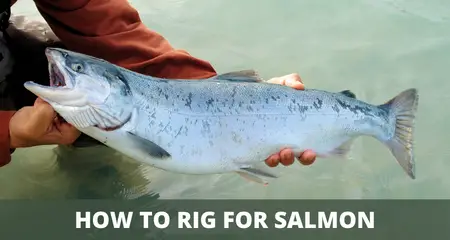
In this article we’ll go over the most effective salmon rigs for both bank fishing and trolling, and will cover what each of them is good for, and how to set them up correctly.
How do you rig for salmon fishing?
The 9 best rigs for salmon are:
- Slip bobber rig
- Spinner rig
- Plunking rig
- Bottom bouncing rig
- 3 way rig
- Flasher rig
- Hoochie rig
- Meat rig
- Mooching rig
The first four setups on this list are salmon rigs for shore fishing, while the other five rigs are for salmon trolling and boat fishing.
Keep in mind that you don’t necessarily need to use all of these rigs, and depending on your fishery and fishing tactic, you may only need one or two rigs to catch salmon.
So the best way to use this guide is to take a quick look at all the rigs, and then test out one or two that are best suited to your salmon fishing setup.
With that being said, in the long run it’s good to test out many different salmon fishing rigs, or variations of each rig.
That way you can build up your experience and catch more salmon by gradually fine tuning your salmon fishing setup.
Salmon rigs for shore fishing
Let’s start by looking at the best salmon rigs for bank fishing.
These are most often used for salmon fishing in rivers, but can also be used from piers and other locations where salmon come close to the shore.
Slip bobber rig for salmon
The slip bobber is the best rig for salmon fishing in rivers, and can be adjusted in size and weight to suit the strength of the current.
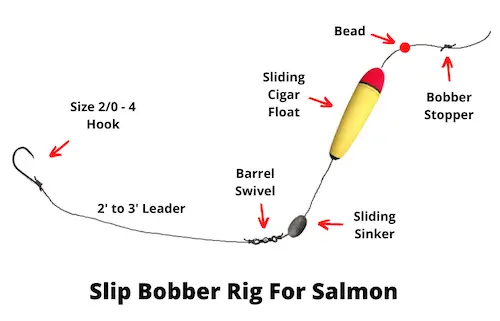
The faster the current, the bigger the bobber and the weight need to be.
How to tie it: Use a 30 to 40 lb test braided line as your main salmon fishing line setup, and start by threading a bobber stopper onto the mainline, followed by a plastic bead (the bead prevents the bobber stopper getting stuck in the slip bobber).
Next, thread a cigar shaped slip bobber onto the main line, followed by a sliding sinker that is matched in weight to the bobber. Following this, tie the main line to a barrel swivel.
Use 15 to 20 lb test fluorocarbon or monofilament for the leader, and use a snell knot to tie that to a size 2/0 to 4 bait keeper hook or octopus hook.
Finally, measure out 2 to 3 feet of leader, and tie the other end to the barrel swivel, and you’re ready to start fishing.
When to use it: The slip bobber rig is a great all around rig and my favorite salmon fishing setup for rivers when using natural baits or live baits.
The great thing about this fishing rig is that you can quickly adjust your fishing depth by sliding the bobber stopper up or down the line, which allows you to cover different fishing depths until you find the right depth for the salmon.
How to use it: Look for holes and runs where salmon are likely to be found, and try to estimate the depth of the water.
Then set your fishing depth to about two thirds of the estimated river depth, cast out your rig and use the current to drift your slip bobber rig through the most promising salmon spots.
If you don’t get a bite, adjust your fishing depth to fish slightly deeper, and repeat the whole process until you start getting hung up on the bottom.
Most salmon bites happen within one or two feet off the bottom, so you’ll need to experiment until you find the right depth.
Salmon spinner rig
The spinner rig is the go-to rig when bank fishing for salmon with lures.
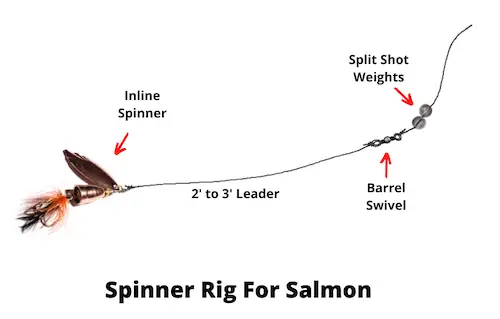
You can use it either with an inline spinner, or any other artificial lure that catches salmon, including spoons, plugs, and crankbaits.
How to tie it: Start by tying your main line (30-40 lb test braid) to a barrel swivel. Next, tie your leader (15-20 lb test fluoro or mono) to a salmon spinner and measure out 2 to 3 feet of leader length.
Finally, tie the leader to the other end of the barrel swivel, and add 2 or 3 split shot weights above the swivel to help get the salmon lure setup down in the water column.
The stronger the current, the more weight you’ll need to add.
When to use it: You can use this fishing rig for salmon in most rivers, as long as the current isn’t too strong.
Keep in mind that you need to get your lure down close to the bottom, which is the main strike zone for salmon.
This can be difficult when the current is very strong, which is why it’s best to look for areas where the current slows down.
How to use it: Cast out your spinner rig, and wait for it to sink down to the bottom (which you can tell by the line going slack). Then start retrieving it with enough speed to avoid getting snagged on the bottom, while staying in the strike zone as long as possible.
Salmon plunking rig
The plunking rig is ideal for fishing for salmon in very strong currents during spring high waters.
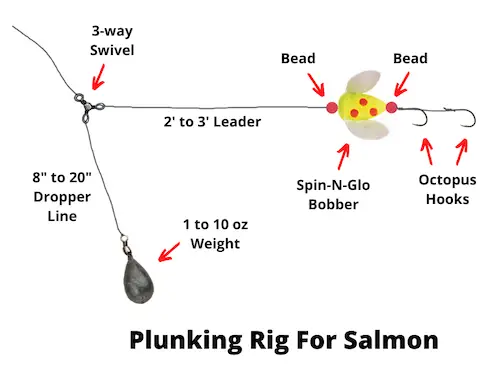
The nice thing about this fishing rig is that you can cast it out and then wait for bites from salmon passing by while migrating upriver.
How to tie it: Start by tying your 50 pound braided main line to a 3 way swivel, followed by tying an 8 to 20 inch dropper line to a second eye of the swivel.
Next, tie a 1 to 10 ounce weight to the other end of the dropper line (the heavier the current, the bigger the weight you’ll need to use).
The dropper line should be weaker than your main line, which allows you to tear off the weight if it gets snagged.
Next, measure out 2 to 3 feet of 20-30 lb test fluorocarbon or monofilament leader line, and tie that to the third eye of the 3 way swivel. Thread a plastic bead onto the leader line, followed by a Spin-n-glo bobber and a second plastic bead.
Finally, tie a 2 hook snell knot to rig two octopus hooks at the end of the leader line.
When to use it: The plunking rig is the go-to choice in high waters with strong currents. Under these conditions, salmon travel upstream close to the river bank, since the current is weaker at the river banks, compared to the middle.
How to use it: Bait your plunking rig with a roe sack, piece of skein, fresh shrimp, or cut herring. Then cast your rig out in locations where salmon come close to the river bank while migrating upstream.
Then place your rod in a rod holder, and wait for bites. By the way, the plunking rig also catches steelhead like a charm.
Bottom bouncing rig for salmon
The bottom bouncing rig is a great option for targeting salmon close to the bottom, since as its name suggests, it’s designed to bounce along the bottom with the current.
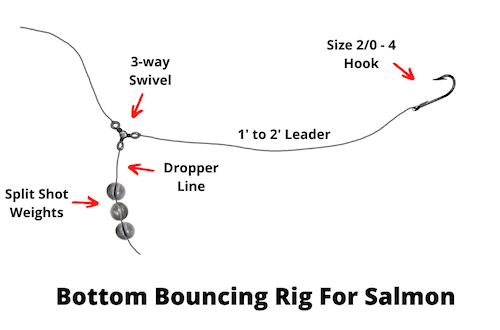
How to tie it: Tie your main line (30-40 lb test braid) to a 3 way swivel, and then tie a short dropper line to another eye ( I like to use 8 inches of 15 lb test mono).
Next, add one or more 1 oz split shot weights to the dropper line. The great thing about this setup is that you can easily add or remove split shots, depending on the strength of the current.
Also, if the split shot weights get snagged, they will slide off the dropper line if you pull on it, leaving your fishing rig intact.
Finally, add a 1 to 3 foot fluorocarbon leader (15-20 lb test), and tie a size 2/0 to size 4 hook to the end of it.
The length of the leader depends on whether your bait floats in the water, and how far off the bottom you want it to float.
When to use it: The bottom bouncing rig is a great choice when fishing for salmon in areas with gravel bottoms, which have relatively few rocks or logs for the rig to get snagged on.
This is important because otherwise you’ll get your rig hung up on every single cast, in which case a slip bobber rig would be a better choice.
The nice thing about this rig is that it automatically targets the bottom zone, which is often the prime strike zone for salmon.
How to use it: Cast out your rig across the river, or slightly upstream from where you’re standing. Then let it sink down to the bottom, and let the current carry it downstream while you keep a tight line.
Detecting bites can be challenging on this fishing rig, because sometimes the line just goes slack because a salmon picked up the bait.
The best thing to do in that case is to slowly reel in line until you feel resistance from the salmon, and then to set the hook.
Salmon rigs for trolling
Now let’s take a look at the best rigs for salmon trolling and boat fishing.
3 way rig for salmon
The 3 way rig is the simplest salmon trolling setup, and is a good option for getting started, or experimenting with salmon trolling in your fishery.
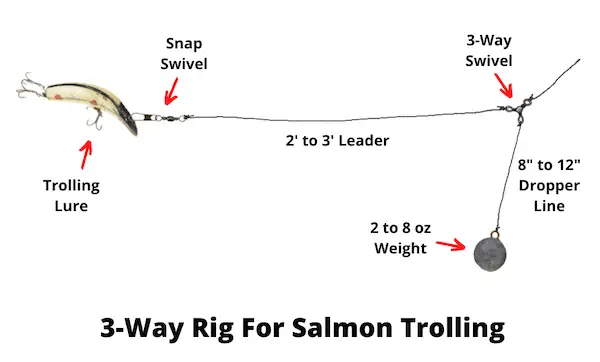
How to tie it: Tie your 65 lb test braided main line to a 3 way swivel, and then tie a 20 lb test dropper line to the second eye of the swivel. At the end of the 8 to 12 inch dropper line, tie a 2 to 8 oz weight.
The size of the weight depends on how deep you need to fish, and this is something you need to figure out by testing.
Next, use a 20 to 30 lb test mono or fluoro to tie a 2 to 5 foot leader to the third eye of the 3 way swivel.
At the other end of the leader tie a snap swivel, which you can use to easily swap out salmon trolling lures.
When to use it: The 3 way rig is a great option when salmon are holding in relatively shallow water under 30 feet, which can be the case in big river systems.
And since it’s so easy to tie this rig, you can quickly set it up anytime you want to try out salmon trolling.
How to use it: Lower your 3 way rig into the water while you’re moving, so that the leader and the dropper line don’t get tangled. This is very important, since a tangled fishing rig is not going to catch any salmon.
Slowly lower the weight until you feel bottom contact, and then try to maintain that depth while trolling.
Ideally, the weight should make contact with the bottom regularly while you’re trolling, since that puts your salmon lure setup in the ideal strike zone above the bottom.
Salmon flasher rig
The flasher rig is one of the most effective salmon trolling rigs there is.
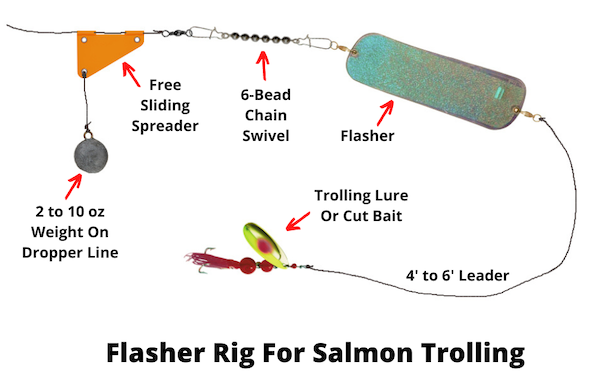
This explains why it’s used by salmon anglers all over North America in lakes, as well as the ocean, and is one of the most commonly used rigs for salmon fishing in Lake Ontario, New York.
If you plan to do a lot of salmon trolling, then this is probably going to be the most important rig for you, as you can catch everything from large chinook salmon to smaller salmon (such as coho or pink salmon) with this setup.
How to tie it: Start by threading a free sliding spreader onto your 65 lb test braided main line, and then tie the main line to a heavy barrel swivel.
Next, tie an 8 to 12 inch dropper line to the bottom hole of the spreader, and tie a 2 to 10 oz weight to the end of the dropper line.
The dropper line should be about 20-30 lb test weaker than your main line, so you can break it off if the weight gets snagged.
Next, add a 6-bead bead chain with snaps attached to both ends to the second eye of the swivel. Attach the other end of the bead chain (also called chain swivel) to a salmon flasher.
You can also use rigging wire instead of a bead chain, which helps to minimize line tangles.
At the other end of the flasher, tie your leader line (20-30 lb test mono or fluoro). Measure out 4 to 6 feet of leader length, and tie the other end to your salmon trolling lure. Another option is to tie it to a snap, which allows you to change your trolling lure easily.
Some of the best salmon trolling lures to use for this include plugs, crankbaits, big inline spinners, hoochies, or spinners rigged in front of hoochies.
When to use it: The flasher rig can be used in pretty much any situation where salmon can be caught by trolling. However, if you want to target salmon in deep water over 50 feet, you’ll need to use this rig with a downrigger, which allows you to get it down into the deep water zones.
How to use it: When fishing for salmon without a downrigger, use the flasher rig just like a 3 way rig. Lower your rig into the water, and release the line until you make bottom contact.
Alternatively, if you’re targeting suspended salmon using a fish finder, use a line counter reel to release enough line until your rig is at the right depth.
Salmon hoochie rig
The hoochie rig can be combined with one of the other trolling rigs for salmon, and is most often used at the end of a salmon flasher rig.
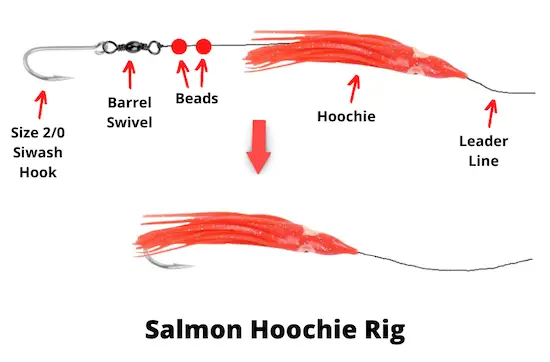
There are countless variations of this rig, and most salmon anglers have their own version of it.
How to tie it: Start by threading a salmon hoochie onto your leader line (20 to 30 lb test monofilament), and then thread two or three beads onto the line below the hoochie.
The number of beads is important, because this determines how far back the hook will be positioned on the rig.
Ideally, you’ll want the hook to trail all the way at the back of the hoochie skirt, in order to avoid short strikes. You can also add a second stinger hook that trails behind the hoochie for this purpose.
Next, tie a barrel swivel to the leader, and then add a size 2/0 siwash hook to the other eye of the swivel. Next, use a pair of pliers to close the eye of the siwash hook, so it can’t fall off.
Finally, tighten the line, and slide the hoochie all the way down onto the beads, until just the hook protrudes from the back of the skirt.
When to use it: The hoochie rig is a great trolling setup that can be tied at the end of a flasher rig or 3 way rig. Some anglers also like to combine it with an inline spinner or a Spin-n-Glo bobber rigged in front of it.
How to use it: Use the hoochie rig for salmon trolling together with the flasher rig, and fish it in the same way that you would troll any other lure for salmon.
Salmon meat rig
A meat rig is a two hook setup used to rig a whole herring or a cut plug herring as bait for salmon trolling or mooching.
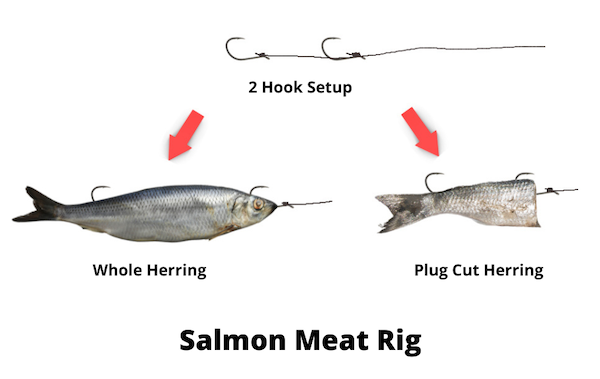
How to tie it: In order to set up a meat rig, you’ll have to tie a 2 hook snell knot, which basically results in 2 hooks rigged in tandem at the end of your leader line. Here is a great video on how to tie a two hook snell knot.
Choose the spacing between the hooks to fit the size of your bait fish or plug cut herring. Alternatively, you can also tie an adjustable 2 hook knot, which allows you to slide the upper hook up or down the line.
When you’re done with the hook knots, tie the other end of your leader to a swivel or snap swivel, which you can then connect to your main line.
When to use it: The meat rig is another great rig to use at the end of a flasher rig. In fact, this combination is probably the most commonly used salmon trolling setup, since it combines the ability of a flasher to attract salmon with the sight and smell of a herring on the meat rig.
How to use it: No matter whether you use a whole or plug cut herring on your meat rig, it’s important to rig it in such a way that it has a tight spin when pulled through the water (and not a wide spin), since this is much more effective for triggering bites from salmon, especially king salmon.
You can use this rig either in combination with a trolling setup, such as the flasher rig, or you can use it for salmon mooching, which we will cover in more detail below.
Salmon rigs for boat fishing
While trolling rigs are designed for salmon fishing from a moving boat, you can also catch salmon from a boat that’s drifting, or at anchor, but this type of salmon fishing set up requires using a mooching rig.
Salmon mooching rig
A mooching rig is a salmon fishing set up for saltwater fishing from an anchored boat, or for drift fishing in the ocean.
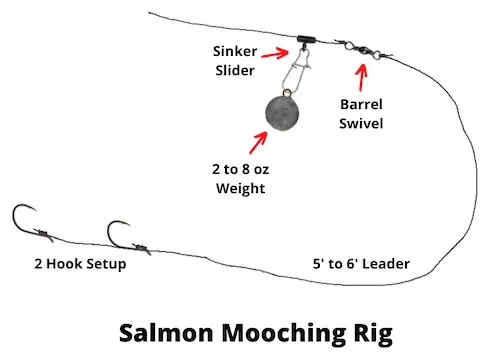
How to tie it: Start by threading a sinker slider onto your main line (50-65 lb test braid), and then attach a 2 to 10 oz weight to the sinker slider.
Next tie the main line to a barrel swivel, and tie the other end to your leader (20-30 lb test fluoro or mono).
Measure out 5 to 6 feet of leader line, and then tie a 2 hook snell knot at the end of the leader (just as in the meat rig).
The 2 hook setup is perfect for rigging either a cut plug herring or a whole herring (or comparable bait fish, such as anchovy or smelt).
When to use it: The salmon mooching rig is a great option if you want to catch salmon in deep waters over 100 feet in bays and other coastal areas. It works equally when fishing for salmon in Alaska in the north to California in the south.
Using this rig successfully requires having a sonar to pinpoint the depth at which salmon are holding, plus a line counter reel that allows you to lower your rig down to that depth.
How to use it: Cast your rig a short distance from the boat, and then use the line counter on your reel to release the line until you reach the depth at which you’re marking salmon on your sonar. Then slowly reel in the rig with periodic pauses, until you feel a bite.
What are the best salmon rigs?
The best all around salmon fishing rig for bank fishing is the slip bobber rig, while the best salmon rig setup for trolling is the flasher rig combined with a herring rigged on a meat rig.
With that being said, however, the best rig to use for salmon fishing depends on where you’re fishing, and what species of salmon you’re targeting.
In general, rigs with natural baits tend to outperform artificial lures, since they also appeal to the keen sense of smell of salmon. On the downside, however, rigs with natural bait are harder to set up, and you need to re-bait them regularly.
At the end of the day, you should also consider which salmon fishing rig set up you enjoy fishing with the most, and consider choosing your favorite salmon fishing tackle setup, even if another rig is more effective.
For example, I personally enjoy salmon mooching more than trolling, since mooching involves holding your rod in your hand while you’re reeling in the bait.
This allows me to feel the characteristic tugs on the line when a salmon takes the bait, which is always a huge thrill to me, and I can then set the hook and fight the salmon.

